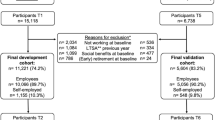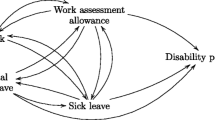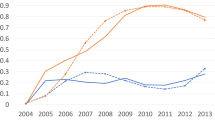Abstract
The implementation of a graded return-to-work (RTW) program to reintegrate the long-term sick started in Germany in 1971 and has been manifested in the Social Code Book V since 1989. Based on a return plan by the physician and the insured, participants increase their working hours slowly over a specified period of time. As participants are still classified as incapable of working they still receive sick leave benefits. Using claims data from the Techniker Krankenkasse, the largest German sickness fund, the study aims at identifying participants and analyzing the full return-to-work and the impact of the RTW program. Thereby, we account for socio-economic factors, insurance-based characteristics, and medical and health-related information. We consider a possible selection bias by using individual weights to analyze determinants of length of the sickness absence by applying models for survival analysis (Cox proportional hazard model). As a main result — depending on the central assumption of unconfoundedness — sickness absence is positively related to participation in the RTW program for those with sickness absence longer than 120 days. For mental disorders, our results indicate an even stronger effect. The study results emphasize the need further promotion of this instrument among those insured, physicians and employers, as occupational health management is one key for a successful return-to-work.


Similar content being viewed by others
Notes
If the participants receive additional benefits from the employer, sickness payments are reduced accordingly. After a rehabilitation treatment, program costs are born by the Statutory Pension Insurance (SPI).
The maximum sickness benefits duration is 78 weeks including continued remuneration by the employer: hence 546 days. Our 517-day period results from the difference between latest start into sickness (31st January 2011) and maximum observation date available (30th June 2012).
The size of the company (i.e. of the operating site) is based upon the definition of the European Commission on small and medium enterprises [36].
To calculate the ATE, a so-called inverse probability of treatment weighting (IPTW) can be used [37]. The formula is: \(w_{i} = \frac{{T_{i} }}{{\hat{e}_{i} }} + \frac{{(1 - T_{i} )}}{{1 - \hat{e}_{i} }}\).
For participants, the weight is \(w_{i} = 1/\hat{e}_{i}\), and for the members of the control group \(w_{i} = 1/(1 - \hat{e}_{i} )\).
The results of the logit model are presented in Table 2. All statistical analyses are based on SAS 9.3/Enterprise Guide 5.1.
In addition, we used a linear interaction as well as a quadratic or cubic interaction. As these implementations designate the functional form of the interaction, we preferred the more flexible dummy approach.
References
Henke, K.D., Martin, K., Behrens, C.: Direkte und indirekte Kosten von Krankheiten in der Bundesrepublik Deutschland 1980 bis 1990 (Direct and indirect cost of illness in the Federal Republic of Germany 1980–1990). J Publ Health. 5, 123–144 (1997)
Bundesanstalt für Arbeitsschutz und Arbeitsmedizin: Volkswirtschaftliche Kosten durch Arbeitsunfähigkeit 2011 (Economic cost of work incapacity 2011). Dortmund (2013)
Bräuninger, M., Sattler, C., Kriedel, N., Völpel, H., Straubhaar, T.: Gesundheitsentwicklung in Deutschland bis 2037—Eine volkswirtschaftliche Kostensimulation (Development of health in Germany in 2037—an economic cost simulation). HWWI Policy Paper 1–6, Hamburg (2007)
Osterkamp, R.: Work lost due to illness—an international comparison. CESifo Forum. 4, 36–40 (2002)
Høgelund, J., Holm, A., McIntosh, J.: Does graded return-to-work improve sick-listed workers’ chance of returning to regular working hours? J Health Econ. 29, 158–169 (2010)
Pélissier, C., Fontana, L., Chauvin, F.: Factors influencing return to work after illness in France. Occup Med-Oxford. 64, 56–63 (2014)
Vlasveld, M.C., van der Feltz-Cornelis, C.M., Bultmann, U., Beekman, A.T., van Hoedeman, M.W.R., Anema, J.R.: Predicting return to work in workers with all-cause sickness absence greater than 4 weeks: a prospective cohort study. J Occ Rehabil. 22, 118–126 (2012)
Silva-Junior, J.S., Fischer, F.M.: Long-term sickness absence due to mental disorders is associated with individual features and psychosocial work conditions. PLoS One. 9, 115885 (2014)
Markussen, S., Røgeberg, O.J.: The anatomy of absenteeism. J Health Econ. 30, 277–292 (2011)
Markussen, S., Mykletun, A., Røed, K.: The case for presenteeism: evidence from Norway’s sickness insurance program. J Public Econ. 96, 959–972 (2012)
Böckerman, P., Laukkanen, E.: What makes you work while you are sick? Evidence from a survey of workers. Eur J Public Health. 20, 43–46 (2010)
Ziebarth, N.R., Karlsson, M.: A natural experiment on sick pay cuts, sickness absence, and labor costs. J Public Econ. 94, 1108–1122 (2010)
Ziebarth, N.R.: Long-term absenteeism and moral hazard: evidence from a natural experiment. Labour Econ. 24, 277–292 (2013)
Ziebarth, N.R., Karlsson, M.: The effects of expanding the generosity of the statutory sickness insurance system. J Appl Econom. 29, 208–230 (2014)
Fevang, E., Hardoy, I., Røed, K.: Getting disabled workers back to work : how important are economic incentives? IZA Discussion Paper No. 7137. Bonn (2013)
Bratsberg, B., Fevang, E., Røed, K.: Job loss and disability insurance. Labour Econ. 24, 137–150 (2013)
Frölich, M., Heshmati, A., Lechner, M.: A microeconometric evaluation of rehabilitation of long-term sickness in Sweden. J Appl Econom. 19, 375–396 (2004)
Laun, L.: Skogman Thoursie, P.: Does privatisation of vocational rehabilitation improve labour market opportunities? Evidence from a field experiment in Sweden. J Health Econ. 34, 59–72 (2014)
Ziebarth, N.R.: Estimating price elasticities of convalescent care programmes. Econ J. 120, 816–844 (2010)
Øyeflaten, I., Lie, S.A., Ihlebæk, C.M., Eriksen, H.R.: Prognostic factors for return to work, sickness benefits, and transitions between these states: a 4-year follow-up after work-related rehabilitation. J Occ Rehabil. 24, 199–212 (2014)
Hofmann, B.: Sick of being “activated?” : vacancy referrals and sickness absence among unemployment insurance benefit recipients. Empir Econ. 47, 1103–1127 (2014)
Bürger, W., Glaser-Möller, N., Kulick, B., Pallenberg, C., Stapel, M.: Stufenweise Wiedereingliederung zulasten der gesetzlichen Rentenversicherung—Ergebnisse umfassender Routinedatenanalysen und Teilnehmerbefragungen [Stepwise occupational reintegration under the German pension insurance scheme–results of comprehensive routine data analyses and participant surveys]. Rehabilitation. 50, 74–85 (2011)
Bürger, W., Streibelt, M.: Wer Profitiert von Stufenweiser Wiedereingliederung in Trägerschaft der gesetzlichen Rentenversicherung? [Who benefits from stepwise occupational reintegration provided under the Statutory Pension Insurance Scheme?]. Rehabilitation. 50, 178–185 (2011)
Everhardt, T.P., de Jong, P.R.: Return to work after long-term sickness: the role of employer based interventions. De Econ 159, 361–380 (2011)
Høgelund, J., Holm, A., Eplov, L.F.: The effect of part-time sick leave for employees with mental disorders. J Ment Health Policy. 15, 157–170 (2012)
Poulsen, O.M., Aust, B., Bjorner, J.B., Rugulies, R., Hansen, J.V., Tverborgvik, T., Winzor, G., Mortensen, O.S., Helverskov, T., Ørbæk, P., Nielsen, M.B.: Effect of the Danish return-to-work program on long-term sickness absence: results from a randomized controlled trial in three municipalities. Scan J Work Env Hea. 40, 47–56 (2014)
Viikari-Juntura, E., Kausto, J., Shiri, R., Kaila-Kangas, L., Takala, E.P., Karppinen, J., Miranda, H., Luukkonen, R., Martimo, K.P.: Return to work after early part-time sick leave due to musculoskeletal disorders: a randomized controlled trial. Scan J Work Env Hea. 38, 134–143 (2012)
Shiri, R., Kausto, J., Martimo, K.P., Kaila-Kangas, L., Takala, E.P., Viikari-Juntura, E.: Health-related effects of early part-time sick leave due to musculoskeletal disorders: a randomized controlled trial. Scand. J. Work Environ. Health 39, 37–45 (2013)
Andrén, D., Andrén, T.: Part-time sick leave as a treatment method? HEDG Working Paper 08/11. University of York (2009)
Andrén, D., Andrén, T.: Starting sick leave part-time as a treatment method? Working Paper 10/2009. Örebro University (2009)
Andrén, D., Andrén, T.: How to evaluate the impact of part-time sick leave on the probability of recovering. Medium Econ Appl 17, 8–13 (2009)
Andrén, D.: Does part-time sick leave help individuals with mental disorders recover lost work capacity? J Occ Rehabil. 24, 344–360 (2014)
Andrén, D., Svensson, M.: Part-time sick leave as a treatment method for individuals with musculoskeletal disorders. J Occ Rehabil. 22, 418–426 (2012)
Ganzeboom, H.B.G., De Graaf, P.M., Treiman, D.J.: A standard international socio-economic index of occupational status. Soc. Sci. Res. 21, 1–56 (1992)
Caliendo, M., Kopeinig, S.: Some practical guidance for the implementation of propensity score matching. J Econ Surv. 22, 31–72 (2008)
European Commission: Commission Recommendation 2003/361/EC. Official Journal of the European Union. L124 20.5.2003, pp 36–41 (2003)
Stuart, E.A.: Matching methods for causal inference: a review and a look forward. Stat Sci. 25, 1–21 (2010)
Verbeek, M.: A guide to modern econometrics, 3rd edn. Wiley, Chichester (2008)
Greene, W.H.: Econometric analysis, 6th edn. Prentice Hall, Upper Saddle River, New Jersey (2008)
Austin, P.C.: A tutorial on the use of propensity score methods with survival or time-to-event outcomes: reporting measures of effect similar to those used in randomized experiments. Stat. Med. (2013). doi:10.1002/sim.5984
Parmar, M.K.B., Machin, D.: Survival analysis: a practical approach. Wiley, Chichester (1995)
Allison, P.D.: Survival analysis using SAS: a practical guide. SAS Publishing, Cary (2010)
Wilson, M. G.: Using SAS to assess and model time-to-event data with non-proportional hazards. Midwest SAS User Group, pp 125–2010 (2010)
Elixhauser, A., Steiner, C., Harris, D.R., Coffey, R.M.: Comorbidity measures for use with administrative data. Med. Care 36, 8–27 (1998)
van Walraven, C., Austin, P.C., Jennings, A., Quan, H., Forster, A.J.: A modification of the Elixhauser comorbidity measures into a point system for hospital death using administrative data. Med. Care 47, 626–633 (2009)
Author information
Authors and Affiliations
Corresponding author
Rights and permissions
About this article
Cite this article
Schneider, U., Linder, R. & Verheyen, F. Long-term sick leave and the impact of a graded return-to-work program: evidence from Germany. Eur J Health Econ 17, 629–643 (2016). https://doi.org/10.1007/s10198-015-0707-8
Received:
Accepted:
Published:
Issue Date:
DOI: https://doi.org/10.1007/s10198-015-0707-8




